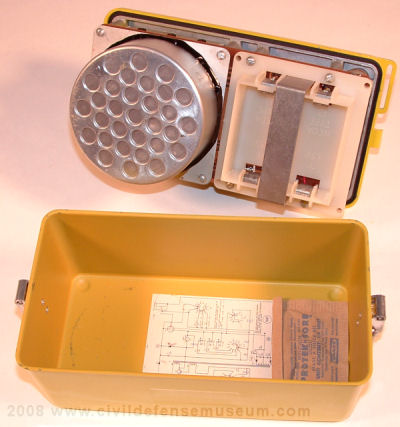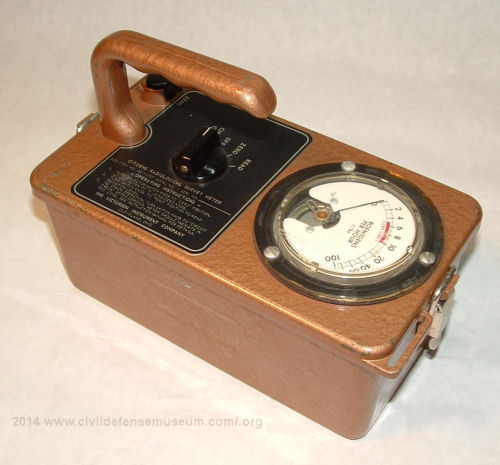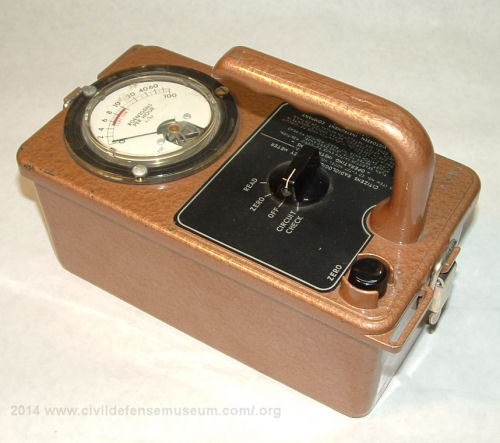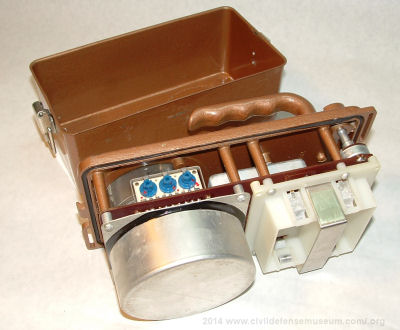| Radiation Inst. Main | Commercially Sold Meters | Two State RADEF Shops |
Commercially Sold Radiation Meters For CD Use
 |
 |
During the height of the civil defense effort some radiation instruments were sold to the public for civil
defense use. Here are some of the more common items I have found over the years. At the bottom
of this page you can check out the "Criteria For Radiation Instruments For Use By The General Public" published
in the Radiological Defense Planning An Operations Guide, March 1967.
Pictured above is the Bendix Family Radiation Measurement Kit that was sold in the 1960s.
The price on the box is $24.95. This kit has a" Lafayette Radio Electronics"
store price tag on it. See Lafayette Radio Advertisement Below.
The Bendix kit consists of instruments very similar to the Civil Defense issued dosimeters and charger with one difference, the CD V-736 Ratemeter. The CD V-736 instrument has 2 scales which are read in 1 and 10 minute time periods. This allows the measururement of radiation in a shorter time similar to a survey meter even though it's still a dosimeter. The instrument is just exposed for the appropriate period of time for the scale being read. The CD V-746 is a high range dosimeter that reads up to 600 roentgens total dose. It's interesting that these instruments also have the "CD-V" as part of their model number even this set was sold to the public. See a description and instructions for this kit of the instruments below.
Bendix Family Radiaton Kit Ratemeter, Dosimeter, And Charger

CD V-736 RatemeterRange 1-120 Roentgens/Hr(exposed for 1 minute) Range 1-12 Roentgens/Hr (exposed for 10 minutes Reads Gamma Radiation |
 |

CD V-746 DosimeterRange 0-600 RoentgensReads Gamma Radiation |
 |
CD V-756 Dosimeter Charger

This is the CD V-756 dosimeter charger that came with the Bendix kit. This charger is the same as the early Civil Defense issue Bendix (CD V-750 Model 5) charger but with a different color case and number.
Bendix Kit Fold-out Instruction Sheet

|
 Click Images To See Larger |
I also have a scan of the Bendix Kit Instruction and Maintanance Manual in Adobe PDF Format.
Early 1960s Lafayette Radio Electronics Advertisement For The Bendix Family Kit

Landsverk Fallout Radiation Measurement Set
 Click To See Larger |
I didn't know that Landsverk ever sold a set like this until I saw this one for sale on ebay in mid-2004. It's very similar to the Bendix set seen above. This set has a "L-746" Personal Dosimeter (0-600 R) which is actually a "IM 93-UD Radiacmeter." The IM 93 label is visible under the paint on the dosimeter and on the scale of the dosimeter. The set also has a "L-730 Dosimeter/Ratemeter" which is basically a CD V-730 with an extra scale added. The extra scale added to the L-730 has 0-200 Roentgens/Hour dose-rate scale in addition to the 0-20 Roentgens scale. The dosimeter charger is marked as a CD V-750 Model 5A. I've never seen a CD V-750 made by Landsverk other than the one in this set. I believe this charger was made by Jordan since the internals and externals are identical to a Jordan CD V-750 Model 5A.
It is also interesting to note that this set is "CD Yellow" and that the charger displays the"CD" emblem. Click the photo to see a larger version.
Landsverk Fallout Radiation Measurement Set Ratemeter, Dosimeter, And Charger

L-730 RatemeterRange 1-200 Roentgens/Hr(exposed for 6 minutes) Range 1-20 Roentgens/Hr (exposed for 1 hour) Reads Gamma Radiation |
 |

L-746 Personal Dosimeter(IM 93/UD)Range 0-600 Roentgens Reads Gamma Radiation |
 |
Landsverk O.C.D.M. Item No. CD V-750 Model No. 5A Dosimeter Charger

This is the dosimeter charger that came with the Landsverk kit. I have never seen a Landsverk made dosimeter charger other than with this kit. Actually I don't think this charger was made by Landsverk. I believe this charger was made by Jordan since the internals and externals are identical to a Jordan CD V-750 Model 5A.
Landsverk Kit Manual
Adobe PDF file of the Landsverk Fallout Radiation Measurement Set Manual of Instructions For Use and maintenanace. 2.1Mb File size.
Victoreen Fallout Detection Meter
 |
 |
This is the Victoreen Fallout detection meter, a commercially sold variant of the CD V-720. The model number of this unit is 61720 which leads me to beleive that this was originally a CD V-720 manufactured in 1961. This meter has a CD V-700 case bottom instead of the CD V-720 bottom with the sliding cover which makes it function as a CD V-715 less the 0.1 scale. This unit was sold by Victoreen for $49.95 in the early 1960s. The black label on the case is affixed over the original cast-in model information label.
The inside of the Fallout Detection Meter (above right photo) reveals the internals of a CD V-720. The ion chamber is the same as a 720 but without the thick aluminum protective plate glued to the bottom.
Victoreen Fallout Detection Meter ManualAdobe PDF file of the instruction and maintenance manual for the Fallout Detection Meter.vicfallmeter.pdf (541Kb File Size)
Victoreen Fallout Detection Meter Ad from "The Fallout Shelter Handbook" by Chuck West published in 1962.

Click to see entire advertisement.
Victoreen CD V-727 Citizens Radiological Survey Meter
 |
 |
The Victoreen CD V-727 Citizens Survey meter is very similar to the Victoreen Fallout Detection Meter (VFDM) but it has only one range instead of the three ranges the VFDM has. It appears the CD V-727 was an effort to make a simpler meter for the "average Joe" to use in a nuclear emergency. It's interesting that this meter has a CD V number where the VFDM doesn't. I don't know which came first the CD V-727 or the VFDM. The CD V-727 scale reads from 0-100 r/hr with the first half of the scale being 1-10 and the second half being 10-100. The CD V-727 also uses a CD V-700 case bottom but has a CD V-715 ion chamber. This meter appears to be different from the other CD meters unlike the VFDM which appears just to be a CD V-720 with a CD V-700 bottom. I don't know how many of these were made or if they were widely sold to the public. I have never seen a published advertisement for one. This CD V-727 doesn't have a serial number on the top label.
Thank You! to Rob Stone of Portsmouth Ohio for this meter!

CRITERIA FOR RADIATION INSTRUMENTS FOR USE BY THE GENERAL PUBLIC (1) |
|---|
|
As a supplement to organized Federal, State, and local monitoring systems, instruments for measuring gamma radiation exposure rates (dose rates) and total exposure (dose) can provide valuable on-the-spot information for the citizen following a nuclear explosion. Where, through choice or necessity, one provides a private shelter for the protection of himself and family, knowledge of the radiation sLtuation lrithin the shelter, the home, and, under some circumstances, in surrounding areas, can be used as a basis for determining appropriate courses of action. Instruments designed for measurement of gamma radiation dose rate (rate meters) and lnstruments for measurement of accumulated gamma radiation dose (dosimeters) can be of value for home use. To meet the needs of an individual or household for measurement of gamma radiatlon followlng a nuclear attack, instruments manufactured for sale to the general public must meet minimum criteria, and it w111 be the responsibility of the manufacturer to assure that his instruments do meet these criteria in all material respects, lf they are to be advertised as being adequate for this purpose. The followlng criteria are essential: 1. Criteria common to both rate meters and dosimeters:
2: Rate meter criteria (in addition to above):
3. Dosimeter criteria (in addition to general specifications in 1, "Criteria common to both rate meter and dosimeters"):
|
| 1. Source: Radiological Defense Planning And Operations Guide, DOD OCD, SM-11.23.2 Revised March 1967, Chapter VII Annex 3 |